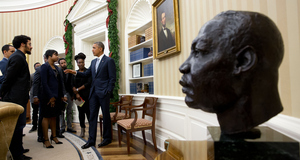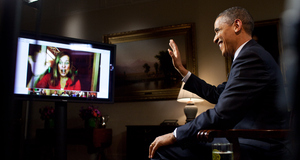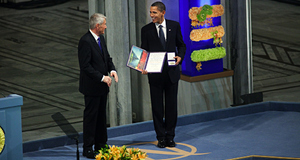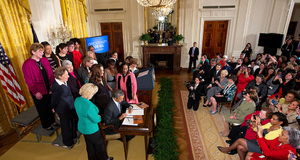The Obama PresidencyInaction on Gun Control Reform During the Obama AdministrationLegislation During President Obama’s AdministrationThree Congresses have served full terms during Obama’s time in office. The 111th served from 2009 through 2010, the 112th from 2011 through 2012, and the 113th from 2013 through 2014. The 114th Congress has been elected but will not assume office until January 2015. Each of these legislative groups has had the opportunity to pass proposed bills that would have overhauled firearm regulations, yet none has done so. During the 111th Congress, limited changes were passed that loosened firearm regulations but there was no progress on major gun control reform. These small changes included allowing the possession of firearms in national parks and on Amtrak trains. Additionally, concealed carry laws were expanded for qualified police officers and the Department of Defense was prohibited from collecting information on firearms owned by military personnel off base. It is important to point out that all of these provisions loosen and expand gun laws rather further regulate them. Despite other attempts at progress, Congress managed to move backwards. During the 112th Congress, the House and Senate were equally unproductive on the issue of gun control. On November 18, 2011, President Obama signed the Consolidated and Further Continuing Appropriations Act, which provided the Bureau of Alcohol, Tobacco, Firearms, and Explosives (ATF) with $1.152 billion in funding for FY2012.15 Beyond this one piece of successful legislation, there were a variety of bills that were passed by the House of Representatives but did not move forward to voting in the Senate or the President’s signature. Similar to the 111th Congress, there was no progress or major reform to the country’s gun control policies. Those that were enacted were very limited in scope and again, in most cases, expanded rights for gun owners and access to guns rather than setting limitations.The 113th Congress, the current session, is arguably the most important to analyze because the members have been in office since the devastating shooting in Newtown, Connecticut on December 14, 2012. In the wake of this shooting, President Obama presented a list of executive orders and desired legislative actions around regulations of firearms. These legislative recommendations include expanding the federal background check system to include the private sale and transfer of weapons outside of federally licensed dealers, reinstating an assault weapons ban that would limit the use of magazines with greater than 10 rounds (such as those used in Newtown), and increase penalties for gun trafficking.16 Congress has passed none of these recommendations. According to the Congressional Research Service, the Senate Committee on the Judiciary approved four bills to go to the floor of the Senate in April 2013. These included the Stop Illegal Trafficking in Firearms Act, the Fix Gun Checks Act, the School Safety Enhancements Act, and the Assault Weapons Ban.17 These bills included nearly every legislative proposal that President Obama recommended and would have represented a huge step forward in firearm regulation. Despite being voted out of committee, each of these bills failed to pass in the full body Senate.18 Instead of these four bills, the Senate ultimately voted on 9 separate amendments related to gun control. All but two were defeated after not attaining a 60-vote majority and the two that did pass did not address the major reforms requested by President Obama. There are only a few weeks left in this session of Congress. The 114th Congress, which will enter office in 2015, has the potential to move forward with gun control regulation but, this is unlikely. The one major difference between this Congress and the current one is the party alignment. The 113th Congress is split with a Democratic Senate and a Republican House of Representatives. In the 114th Congress, Republicans will control both the House and the Senate. While this may increase the chances of legislation being passed by both houses, it is unlikely that a Republican controlled Congress will consider legislation pertaining to increased firearm regulations. Public SupportIn addition to the history of firearm legislation, it is critical to explore public support for reform. The public overwhelmingly supports gun control and reform. As previously demonstrated, an increase in daily gun violence and mass shootings places the prevalence and consequences of guns squarely in the public’s line of vision. These events have mobilized public support for reasonable gun control reforms. This should spur Congress to take action on reform, yet this has failed to occur. Several of President Obama’s requested provisions for gun control legislation have garnered national attention and support. The first is required background checks for all sales and transfers of firearms. This expands the requirements of the Brady Act that only covered transactions between individuals and federally licensed dealers registered as businesses. The second proposed provision is a federal registry and database that will track all gun sales. This would allow law enforcement officials to determine where criminals gain access to their weapons and thus work to reduce the number of illegally owned and sold guns. The final provision that has garnered attention is a reinstatement of a federal assault weapons ban and/or limitation of all magazines to ten rounds or less. In various polls, all three of these measures have received majority support and, in many cases, overwhelming support. According to a 2013 poll by the Pew Research Center, 81% of those surveyed supported making all gun sales subject to background checks. In that same survey, 66% of those surveyed supported a federal database to track gun sales and 54% supported a federal ban on assault-style weapons.19 A poll conducted by Gallup in April 2013 shows similar numbers, further indicating a high level of support for these policies. This polling showed that 83% of those surveyed supported background checks for all gun sales, again representing the vast majority of Americans. Additionally, 56% showed support for a federal assault weapons ban and 51% supported limiting magazines to ten rounds.20 These polls demonstrate clear support of the American public for various gun control proposals. The support of the public and the increased salience of an issue are critical in any drive for reform. However, given the partisan nature of today’s politics, this has not been enough for legislation to take hold. The Courts and GunsAn analysis of gun control legislation would be incomplete without an analysis of the role of the courts. There have been several challenges to gun control legislation at the federal level, however, the most prominent two cases occurred during President Obama’s time in office. Throughout the 20th Century, the Supreme Court and Federal Courts of Appeal handed down decisions that discussed the role of the 2nd Amendment. It was not until 2001, however, that the meaning and interpretation was truly drawn into question. In 1942, decisions in Cases v. United States (First Circuit) and United States v. Tot (Third Circuit) upheld the federal governments interpretation of the 2nd Amendment as a collective right, rather than an individual right, to bear arms.21 Alternatively, in 2001, the Fifth’s Circuit handed down their decision in United States v. Emerson, which stated that the 2nd Amendment conferred an individual right to bear arms. Then, in 2007, in Parker v. District of Columbia, the D.C. Circuit struck down gun control legislation on the basis that the 2nd Amendment conferred that individual right.22 This difference in opinion would soon fundamentally change the interpretation of the Second Amendment. It was no longer clear whether the right to bear arms should be interpreted as a collective right or an individual right. The Parker decision set the stage for the Supreme Court to make the final decision. Did the 2nd Amendment give individuals the right, broadly stated, to possess firearms? The Court ruled in 2008 in District of Columbia v. Heller that the 2nd Amendment did guarantee an individual right to possess firearms, outside of militia service, and thus the laws in the District of Columbia were unconstitutional.23 This decision vastly altered the interpretation of the 2nd Amendment and laid the groundwork for a variety of changes in both federal and state laws. The most recent case concerning gun control was McDonald v. Chicago in 2010. In this case, the Supreme Court handed down a decision stating that all local and state gun laws must abide by the 2nd Amendment, extending the concept of “incorporation” to this Amendment.24 Principles of incorporation had previously been extended to states with respect to other amendments but this was the first time the Second Amendment was included. This decision was incredibly important because it allowed for the same application of scrutiny to state and local laws as to federal laws. These two decisions by the Supreme Court during Obama’s tenure fundamentally altered the perception of the 2nd Amendment and gun control laws in the United States. The rulings opened the floodgates to a vast number of new legislative possibilities at the federal, state, and local levels. Given an individual right to possess firearms, the question of what reasonable rules and regulations should be put in place to govern this individual right quickly arose. This responsibility fell to Congress and yet, they have done very little to address the issue. The circumstances were now in place for organizations to fight against President Obama’s gun control reforms. The next major case gave them the ability to act on those circumstances. Citizens United v. Federal Election CommissionIn 2010, the United States Supreme Court handed down another landmark decision. Citizens United v. Federal Election Commission was a challenge to existing campaign finance laws and the rules surrounding political contributions. This case “helped unleash unprecedented amounts of outside spending in the 2010 and 2012 election cycles.” Furthermore, the decision spurred the creation of super PACs and the evolution of “dark money” which is funding that can be provided by an organization without disclosure of the original source. 25 Specifically, the decision ushered in three fundamental changes. First, corporations and unions were able to, for the first time, use funds from their general treasuries to pay for independent expenditures for political candidates. Prior to this, unions and corporations could only use funds that were donated specifically for that purpose. Second, Citizens United allowed for the formation of super PACs, which can accept unlimited amounts of money from corporations and wealthy individuals for independent expenditures. Finally, the decision permitted organizations with a non-profit 501c designation to provide funding without disclosing donors.26 The Center for Responsive Politics findings on the effects of the Citizens United decision highlight these points. Since the 2006 midterm elections, the percentage of spending by groups that are no longer required to disclose their donors has risen from 1% to 47%. Furthermore, 72% of spending for political advertising during the 2010 election cycle came from groups that were prohibited from spending prior to the Citizens United decision.27 Overall, since the ruling, political spending by outside groups has increased at an exponential rate. According to the Center for Responsive Politics, outside spending has increased 338% since the 2006 midterm elections. There was approximately $50 million in outside spending during the 2006 election cycle, increasing to nearly $300 million during both the 2008 and 2010 elections. This trend continued in 2012, with outside spending reaching a total of over $1 billion for the first time.28 This is over triple the 2008 total and represents roughly a 2000% increase from the $50 million spent in 2006. As a result of these new rules and regulations, Citizens United fundamentally shifted Congressional focus from the policy opinions of the general public to those of corporations and super PACs. By allowing corporations, unions, and wealthy donors to contribute unlimited sums of money to elections campaigns and candidates, in many cases secretly, the Supreme Court created the opportunity for these organizations to have undue influence on the policy making process. Wealthy individuals and organizations expect legislative cooperation from members of Congress in return for large donations and independent expenditures for their campaigns. Alternatively, given the heightened necessity of money during the election process, members of Congress rely on these large donations to both be elected and then reelected into office. During the 2012 election cycle, there were 1,711 candidates for the House of Representatives who spent, on average, $623,105 each of in their races. For the Senate, the average cost of an election was $2,794,058 in 2012.29 If these members want to be re-elected, they must ensure that they are meeting the requests of large corporations, thereby securing money for their next campaign. This brings to the forefront a major problem. The general public no longer has the same ability to influence the policy decisions of lawmakers. The vast majority of individuals cannot compete with the financial coffers of large corporations, unions, or organizations like the NRA. More specifically to this issue, if the public overwhelmingly supports gun control reform, as has been demonstrated, there should be a clear path to passing legislation. This has obviously not been the case. What’s is arguably more important is that these decisions opened the doors for the NRA and other donors and organizations to have even greater influence around this issue. The NRA themselves issued a press release the day of the decision stating, “The National Rifle Association praised the U.S. Supreme Court's decision today in the case ofCitizens United v. Federal Election Commission, removing unconstitutional restrictions on the NRA’s ability to speak freely at election time.”30 This Supreme Court decision and the precedents it set it are at least partially to blame for the lack of action in Washington on the variety of gun control legislation proposals put forward in the last several years. Given this vast increase in spending, legislators in both parties in Congress have been forced further towards their ideological extremes.31 The overall partisanship in Congress is at an all-time high and the total number of bills passed is at an all-time low.32 There is no doubt a correlation between the level of partisanship in Congress and the number of bills passed.33 This lack of action on all legislative issues due to partisanship becomes startlingly clear on the issue of firearm legislation. Despite overwhelming public support for many gun control reforms, partisanship and lack of compromise has driven the lack of results.Continued on Next Page » Suggested Reading from Inquiries Journal
Inquiries Journal provides undergraduate and graduate students around the world a platform for the wide dissemination of academic work over a range of core disciplines. Representing the work of students from hundreds of institutions around the globe, Inquiries Journal's large database of academic articles is completely free. Learn more | Blog | Submit Latest in Political Science |


















